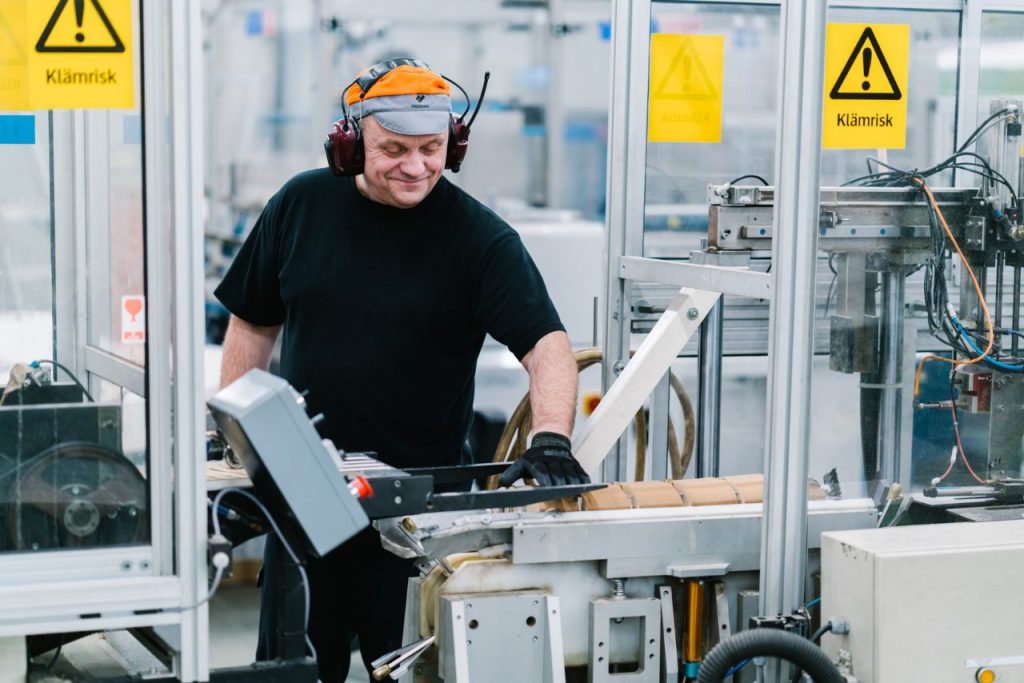Category
How to build a food brand with food packaging: Rebl Eats sandwiches
How a food product is packaged is an important part of building a successful food brand. Rebl Eats sandwiches are packed in cardboard boxes made by Fredman in Rauma with their own printing. Food packaging is often the first chapter in a story about responsibility and change.
Competition is fierce in the ready meals market, especially for a new challenger brand. Finnish Rebl Eats brings a new way of thinking to the industry with its high-quality plant-based ready meals. The message must stand out effectively in the food product itself.
Food packaging plays a key role in building the Rebl Eats brand. Its task is to inform the consumer about the brand’s distinguishing factors, values and the quality of the food product itself at the first encounter at the store shelf.
The triangular sandwich boxes manufactured by Fredman at the Rauma factory support the brand look, tell its story and communicate the company’s values in many ways. The goal is of course to attract the consumer to buy delicious sandwich. And also to arouse the desire to be part of the change and the mission of Rebl Eats.
Food packaging is a central, multidimensional choice
Rebl Eats chose Fredman’s cardboard sandwich boxes for its sandwiches. The choice was guided by values, the quality of the packaging and the possibility of realizing the brand look in the packaging with contract manufacturing.

Lauri Paatela is one of the four founders of Rebl Eats and responsible for its brand and marketing. He elaborates that the selection criteria included, among other things, the recyclability of the packaging material, the responsibility of the manufacturing process and of course the technical characteristics of the packaging. Alternatives were examined from several European operators.
“We were satisfied when we found the best domestic option in all respects”, Paatela sums up. He says that Fredman’s cardboard sandwich boxes were also the most visually stylish.
The stylish, ecological sandwich packaging is produced responsibly in Finland
The ecological food packaging of sandwiches is made from cardboard with renewable energy in Rauma. The packaging material itself repeats the natural look of the Rebl Eats brand.
Since we wanted to minimize the amount of packaging material, the black prints in line with the brand look are implemented directly on the bread packaging. The end result is elegant and clear.
“You see a lot of overpackaged products in stores. It can turn against itself, for example, in how the product looks to the consumer and, of course, in the costs too,” explains Paatela.
It was also important that the attractive, fresh food products are properly visible to the customer standing by the store shelf through the windowed sandwich box. The food must look so good that there is no need or even worth hiding it behind the packaging.
Food packaging in line with the brand’s look gives you a competitive advantage

The taste of ready-made food products is of course the key secret to success. The technical features of the packaging, such as the PET-film of the sandwich box, protect it and its external essence tells the story.
“When the company’s food product has been polished to be super good, it is often time to take the next step and design and manufacture customized, high-quality food packaging with your own printing. It brings more professionalism to the operation, increases trust and helps the brand and its products stand out”, sums up Fredman’s sales manager Tommi Tenhunen.
As a whole, packaging that clearly and confidently reproduces the look of the brand brings credibility to the food product. And also to the company in the minds of both the retail trade and the consumer.
It is easier to get to the selections when the food packaging is high-quality and ecological. In the case of Rebl Eats, the goal is the international market, even if it has already been achieved. Standing out with packaging that tells a story is critical. The concept must work in every market, Paatela states.
The manufacture and use of food packaging is governed by legislation

Fredman manufactures several different types of food packaging with contract manufacturing. Responsibility comes first, in Rauma, where more than 70% of all products in the company’s range are manufactured.
Packaging materials that come into contact with food are controlled through food industry legislation. All Fredman food packaging is manufactured in such a way that it is suitable for the intended use and conditions. In the same way, the properties of the food must remain unchanged and they must not cause harm to the health of the person consuming the food.
The values of Fredman and Rebel Eats collide. Quality is not compromised and a responsible, value-based operating method is a matter of course for both companies and part of the brand. There is still work to be done, even though we have come a long way.
“We don’t need to tell you separately that our products are responsibly packaged, if our choice of materials already communicates that,” says Paatela.
Katia Gustafsson joins Fredman’s Board
Katia Gustafsson has been appointed as a new member of the Fredman Group Board.
Read moreFredman invests in its production in Rauma – production capacity increased for baking papers and pans
Fredman invests in the development of its production and modernisation of main production lines. This marks the most significant reform...
Read more